Page 89 of 108
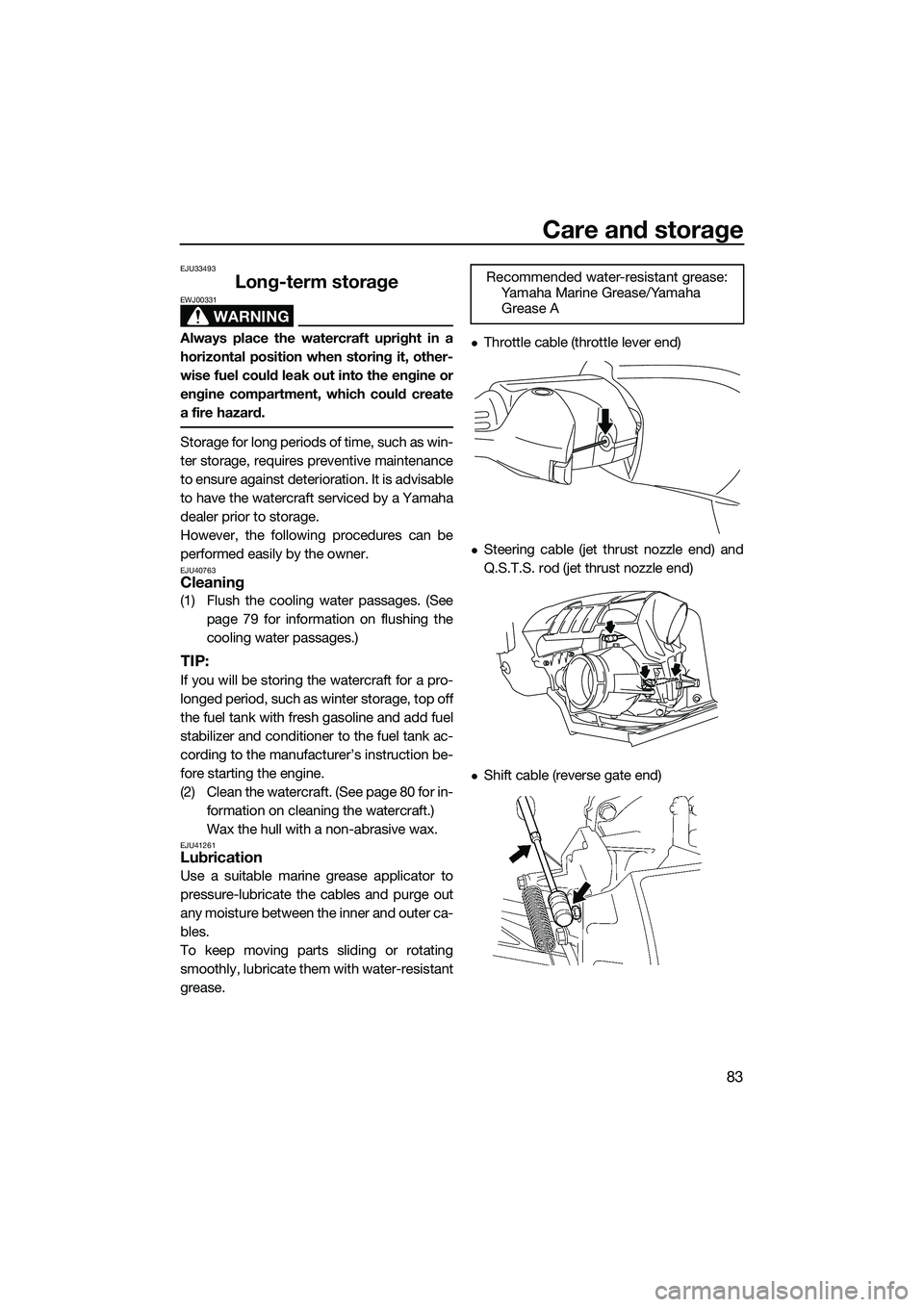
Care and storage
83
EJU33493
Long-term storage
WARNING
EWJ00331
Always place the watercraft upright in a
horizontal position when storing it, other-
wise fuel could leak out into the engine or
engine compartment, which could create
a fire hazard.
Storage for long periods of time, such as win-
ter storage, requires preventive maintenance
to ensure against deterioration. It is advisable
to have the watercraft serviced by a Yamaha
dealer prior to storage.
However, the following procedures can be
performed easily by the owner.
EJU40763Cleaning
(1) Flush the cooling water passages. (Seepage 79 for information on flushing the
cooling water passages.)
TIP:
If you will be storing the watercraft for a pro-
longed period, such as winter storage, top off
the fuel tank with fresh gasoline and add fuel
stabilizer and conditioner to the fuel tank ac-
cording to the manufacturer’s instruction be-
fore starting the engine.
(2) Clean the watercraft. (See page 80 for in-formation on cleaning the watercraft.)
Wax the hull with a non-abrasive wax.
EJU41261Lubrication
Use a suitable marine grease applicator to
pressure-lubricate the cables and purge out
any moisture between the inner and outer ca-
bles.
To keep moving parts sliding or rotating
smoothly, lubricate them with water-resistant
grease.
Throttle cable (throttle lever end)
Steering cable (jet thrust nozzle end) and
Q.S.T.S. rod (jet thrust nozzle end)
Shift cable (reverse gate end)Recommended water-resistant grease:
Yamaha Marine Grease/Yamaha
Grease A
UF3K70E0.book Page 83 Tuesday, November 5, 2013 8:44 AM
Page 91 of 108
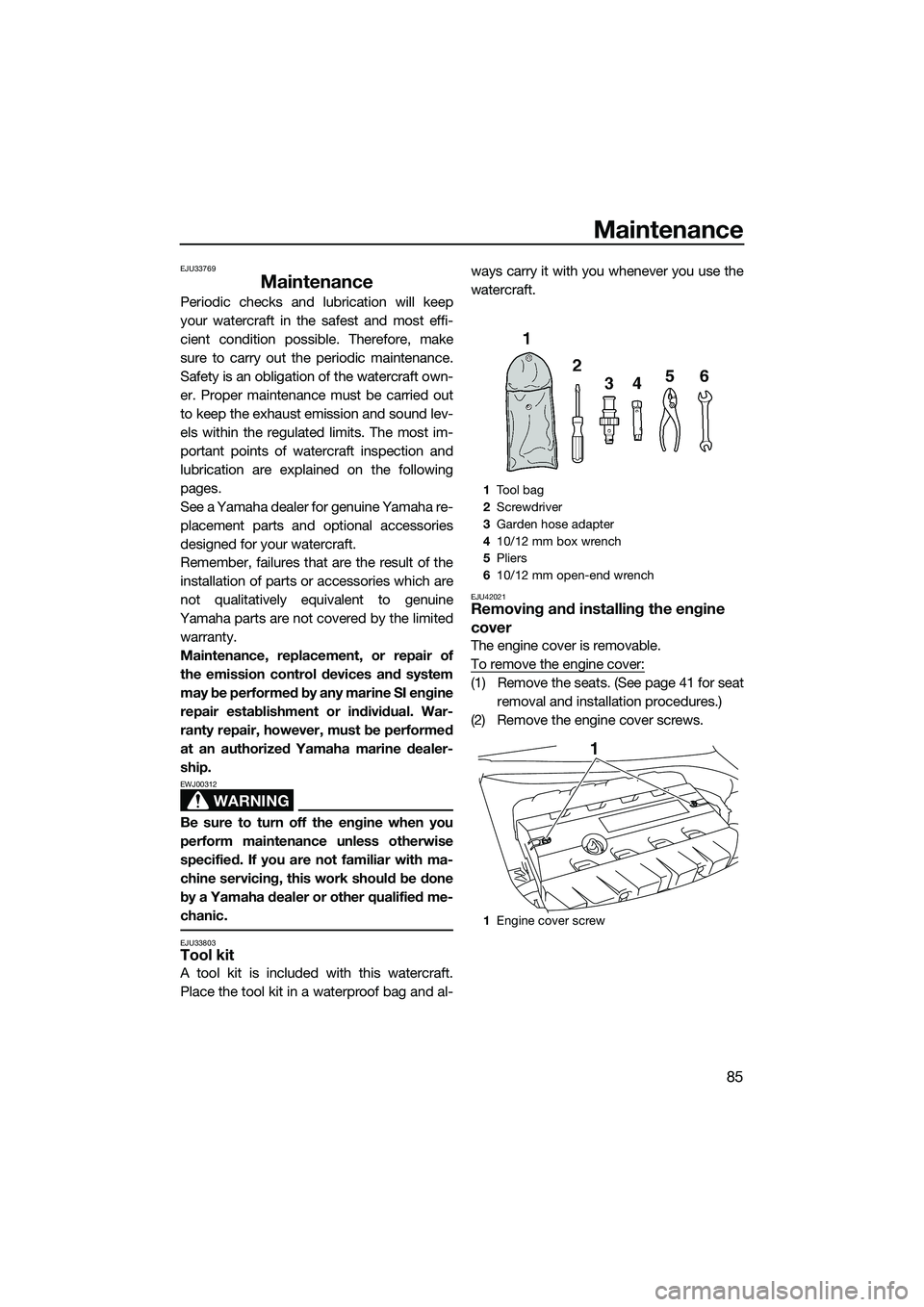
Maintenance
85
EJU33769
Maintenance
Periodic checks and lubrication will keep
your watercraft in the safest and most effi-
cient condition possible. Therefore, make
sure to carry out the periodic maintenance.
Safety is an obligation of the watercraft own-
er. Proper maintenance must be carried out
to keep the exhaust emission and sound lev-
els within the regulated limits. The most im-
portant points of watercraft inspection and
lubrication are explained on the following
pages.
See a Yamaha dealer for genuine Yamaha re-
placement parts and optional accessories
designed for your watercraft.
Remember, failures that are the result of the
installation of parts or accessories which are
not qualitatively equivalent to genuine
Yamaha parts are not covered by the limited warranty.
Maintenance, replacement, or repair of
the emission control devices and system
may be performed by any marine SI engine
repair establishment or individual. War-
ranty repair, however, must be performed
at an authorized Yamaha marine dealer-
ship.
WARNING
EWJ00312
Be sure to turn off the engine when you
perform maintenance unless otherwise
specified. If you are not familiar with ma-
chine servicing, this work should be done
by a Yamaha dealer or other qualified me-
chanic.
EJU33803Tool kit
A tool kit is included with this watercraft.
Place the tool kit in a waterproof bag and al- ways carry it with you whenever you use the
watercraft.
EJU42021Removing and installing the engine
cover
The engine cover is removable.
To remove the engine cover:
(1) Remove the seats. (See page 41 for seat
removal and installation procedures.)
(2) Remove the engine cover screws.
1 Tool bag
2 Screwdriver
3 Garden hose adapter
4 10/12 mm box wrench
5 Pliers
6 10/12 mm open-end wrench
1 Engine cover screw
1
UF3K70E0.book Page 85 Tuesday, November 5, 2013 8:44 AM
Page 95 of 108
Maintenance
89
EJU36943Engine oil and oil filter
WARNING
EWJ00341
Engine oil is extremely hot immediately af-
ter the engine is turned off. Coming in con-
tact with or getting any engine oil on your
clothes could result in burns.
NOTICE
ECJ00992
Do not run the engine with too much or not
enough oil in the engine, otherwise the en-
gine could be damaged.
It is recommended to have a Yamaha dealer
change the engine oil and the engine oil filter.
However, if you choose to change the oil and
filter on your own, consult a Yamaha dealer.
UF3K70E0.book Page 89 Tuesday, November 5, 2013 8:44 AM
Page 98 of 108
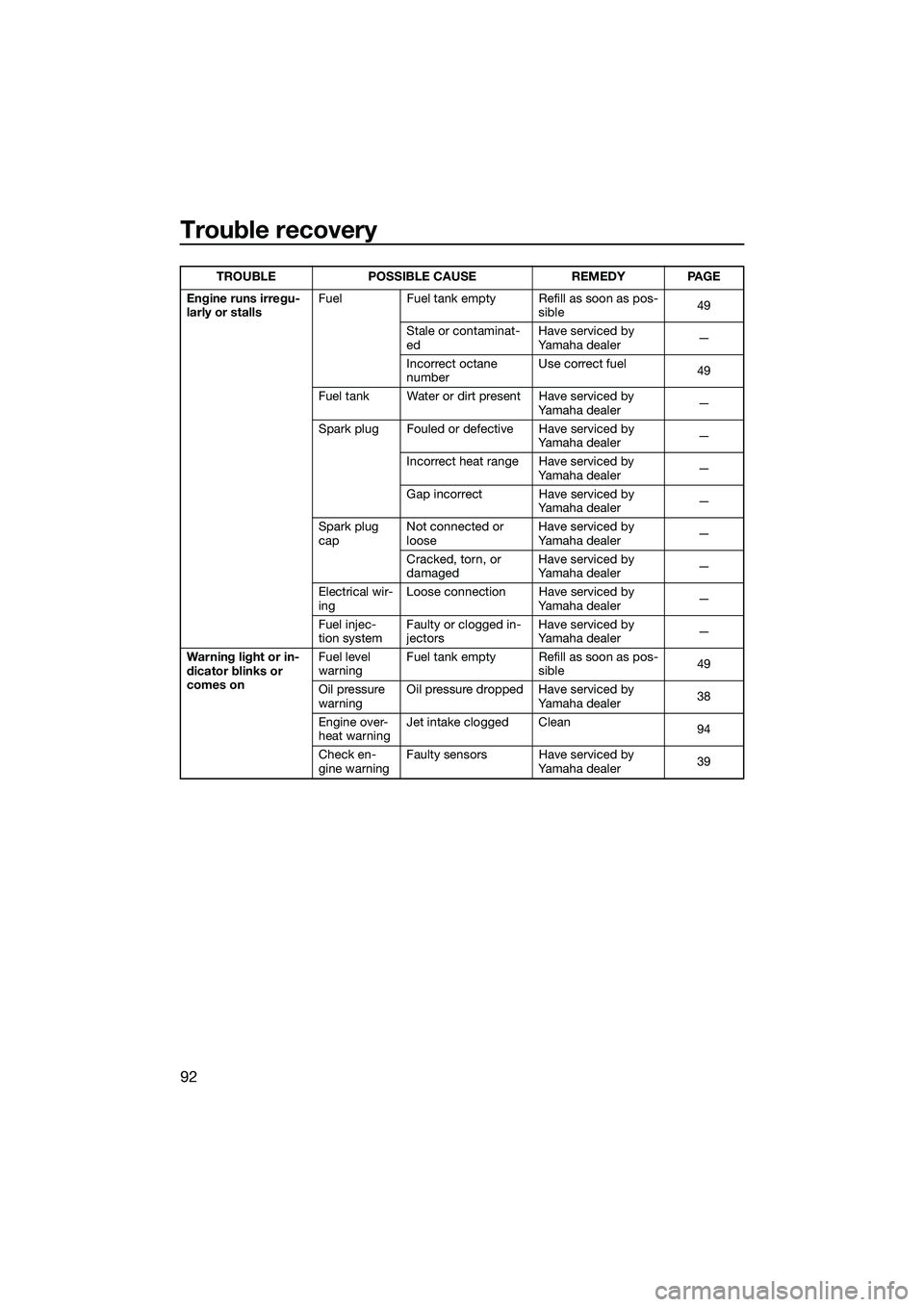
Trouble recovery
92
Engine runs irregu-
larly or stallsFuel Fuel tank empty Refill as soon as pos-
sible49
Stale or contaminat-
ed Have serviced by
Yamaha dealer
—
Incorrect octane
number Use correct fuel
49
Fuel tank Water or dirt present Have serviced by Yamaha dealer—
Spark plug Fouled or defective Have serviced by Yamaha dealer—
Incorrect heat range Have serviced by Yamaha dealer —
Gap incorrect Have serviced by Yamaha dealer —
Spark plug
cap Not connected or
loose Have serviced by
Yamaha dealer
—
Cracked, torn, or
damaged Have serviced by
Yamaha dealer
—
Electrical wir-
ing Loose connection Have serviced by
Yamaha dealer —
Fuel injec-
tion system Faulty or clogged in-
jectors Have serviced by
Yamaha dealer
—
Warning light or in-
dicator blinks or
comes on Fuel level
warning
Fuel tank empty Refill as soon as pos-
sible 49
Oil pressure
warning Oil pressure dropped Have serviced by
Yamaha dealer 38
Engine over-
heat warning Jet intake clogged Clean
94
Check en-
gine warning Faulty sensors Have serviced by
Yamaha dealer 39
TROUBLE POSSIBLE CAUSE REMEDY PAGE
UF3K70E0.book Page 92 Tuesday, November 5, 2013 8:44 AM
Page 99 of 108
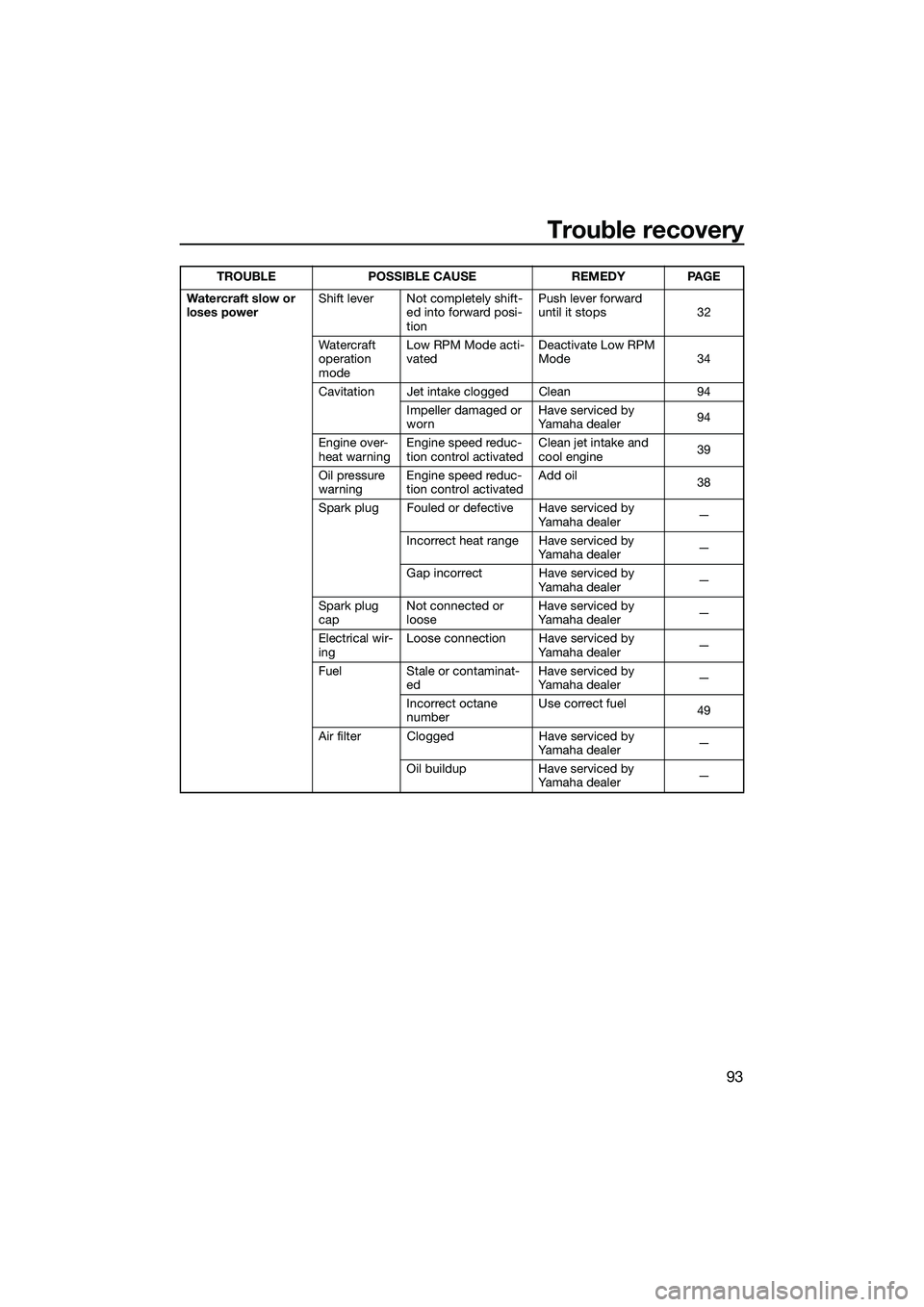
Trouble recovery
93
Watercraft slow or
loses powerShift lever Not completely shift-
ed into forward posi-
tion Push lever forward
until it stops 32
Watercraft
operation
mode Low RPM Mode acti-
vated
Deactivate Low RPM
Mode 34
Cavitation Jet intake clogged Clean 94 Impeller damaged or
worn Have serviced by
Yamaha dealer
94
Engine over-
heat warning Engine speed reduc-
tion control activated Clean jet intake and
cool engine
39
Oil pressure
warning Engine speed reduc-
tion control activated Add oil
38
Spark plug Fouled or defective Have serviced by Yamaha dealer—
Incorrect heat range Have serviced by Yamaha dealer —
Gap incorrect Have serviced by Yamaha dealer —
Spark plug
cap Not connected or
loose Have serviced by
Yamaha dealer
—
Electrical wir-
ing Loose connection Have serviced by
Yamaha dealer —
Fuel Stale or contaminat- ed Have serviced by
Yamaha dealer
—
Incorrect octane
number Use correct fuel
49
Air filter Clogged Have serviced by Yamaha dealer—
Oil buildup Have serviced by Yamaha dealer —
TROUBLE POSSIBLE CAUSE REMEDY PAGE
UF3K70E0.book Page 93 Tuesday, November 5, 2013 8:44 AM
Page 100 of 108
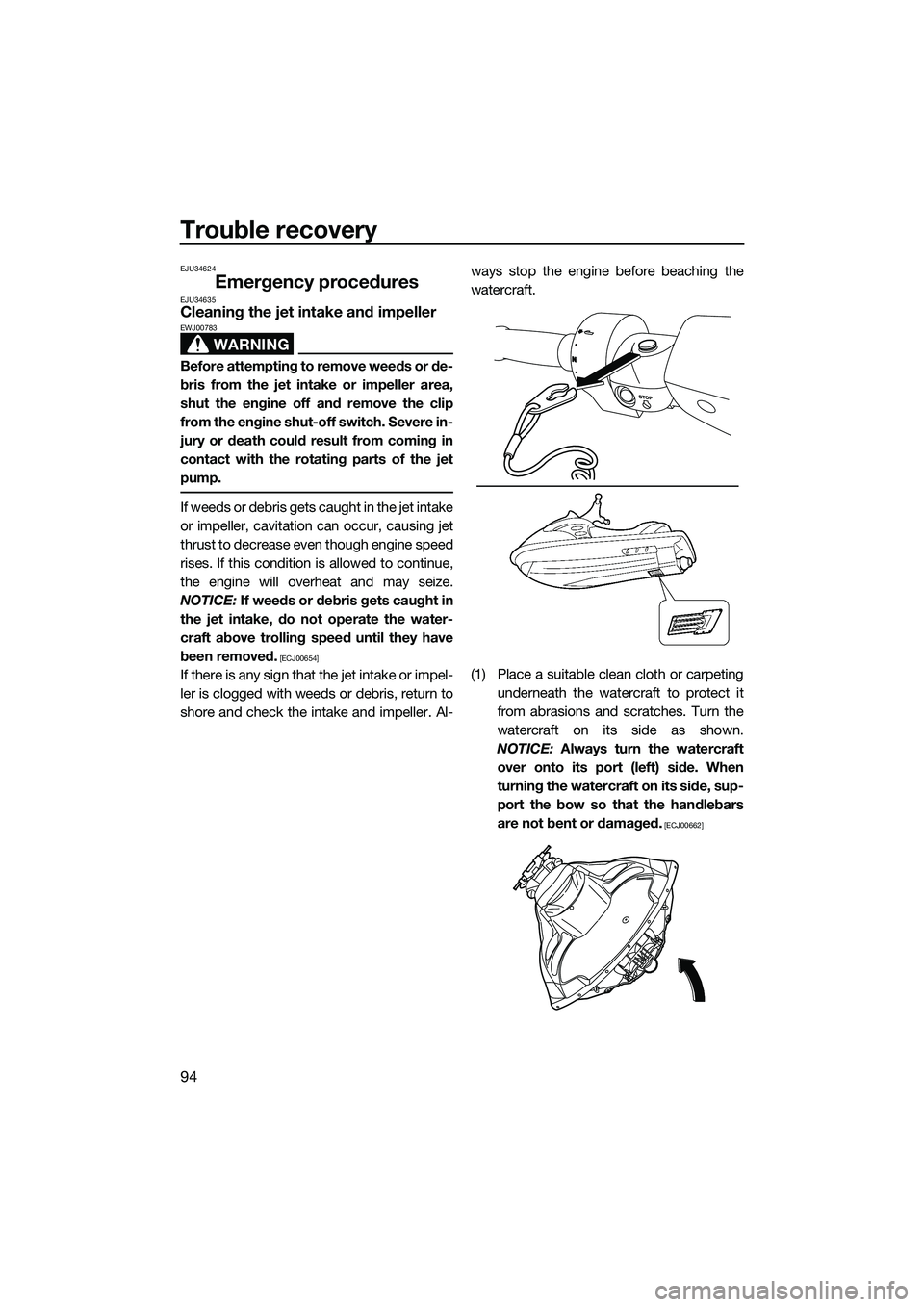
Trouble recovery
94
EJU34624
Emergency proceduresEJU34635Cleaning the jet intake and impeller
WARNING
EWJ00783
Before attempting to remove weeds or de-
bris from the jet intake or impeller area,
shut the engine off and remove the clip
from the engine shut-off switch. Severe in-
jury or death could result from coming in
contact with the rotating parts of the jet
pump.
If weeds or debris gets caught in the jet intake
or impeller, cavitation can occur, causing jet
thrust to decrease even though engine speed
rises. If this condition is allowed to continue,
the engine will overheat and may seize.
NOTICE: If weeds or debris gets caught in
the jet intake, do not operate the water-
craft above trolling speed until they have
been removed.
[ECJ00654]
If there is any sign that the jet intake or impel-
ler is clogged with weeds or debris, return to
shore and check the intake and impeller. Al- ways stop the engine before beaching the
watercraft.
(1) Place a suitable clean cloth or carpeting
underneath the watercraft to protect it
from abrasions and scratches. Turn the
watercraft on its side as shown.
NOTICE: Always turn the watercraft
over onto its port (left) side. When
turning the watercraft on its side, sup-
port the bow so that the handlebars
are not bent or damaged.
[ECJ00662]
UF3K70E0.book Page 94 Tuesday, November 5, 2013 8:44 AM
Page 101 of 108
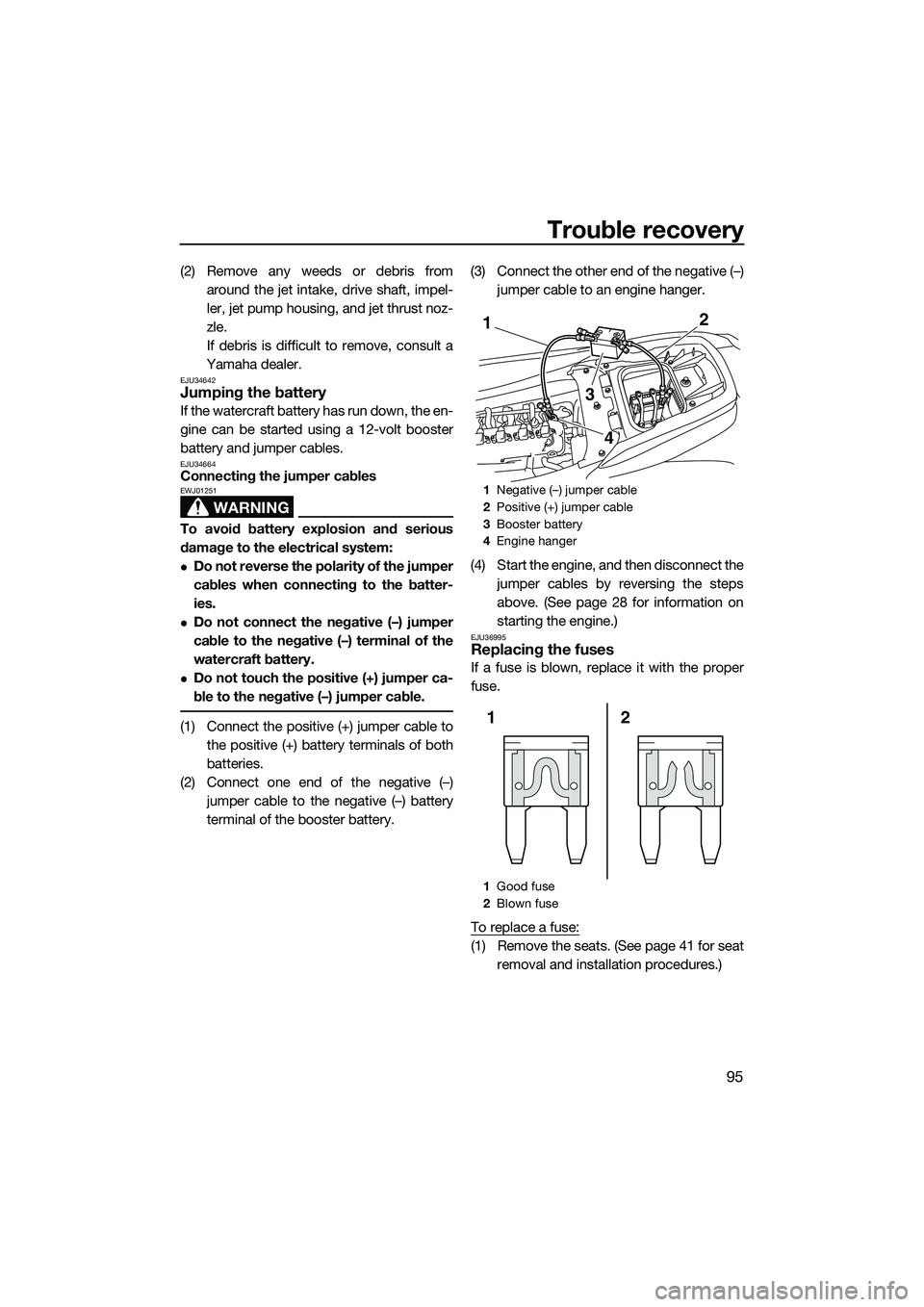
Trouble recovery
95
(2) Remove any weeds or debris fromaround the jet intake, drive shaft, impel-
ler, jet pump housing, and jet thrust noz-
zle.
If debris is difficult to remove, consult a
Yamaha dealer.
EJU34642Jumping the battery
If the watercraft battery has run down, the en-
gine can be started using a 12-volt booster
battery and jumper cables.
EJU34664Connecting the jumper cables
WARNING
EWJ01251
To avoid battery explosion and serious
damage to the electrical system:
Do not reverse the polarity of the jumper
cables when connecting to the batter-
ies.
Do not connect the negative (–) jumper
cable to the negative (–) terminal of the
watercraft battery.
Do not touch the positive (+) jumper ca-
ble to the negative (–) jumper cable.
(1) Connect the positive (+) jumper cable to the positive (+) battery terminals of both
batteries.
(2) Connect one end of the negative (–) jumper cable to the negative (–) battery
terminal of the booster battery. (3) Connect the other end of the negative (–)
jumper cable to an engine hanger.
(4) Start the engine, and then disconnect the jumper cables by reversing the steps
above. (See page 28 for information on
starting the engine.)
EJU36995Replacing the fuses
If a fuse is blown, replace it with the proper
fuse.
To replace a fuse:
(1) Remove the seats. (See page 41 for seatremoval and installation procedures.)
1Negative (–) jumper cable
2 Positive (+) jumper cable
3 Booster battery
4 Engine hanger
1 Good fuse
2 Blown fuse
2
3
1
4
2
1
UF3K70E0.book Page 95 Tuesday, November 5, 2013 8:44 AM
Page 102 of 108
Trouble recovery
96
(2) Remove the electrical box cover.
(3) Loosen the cap on the electrical box andremove it.
(4) Replace the blown fuse with the spare fuse of the correct amperage by using
the fuse puller on the reverse side of the
cap. WARNING! Do not use fuses of a
different amperage than recommend-
ed. Substitution with a fuse that has
an improper rating can cause exten- sive electrical system damage and
possible fire.
[EWJ00803]
(5) Securely install the cap by tightening it
until it stops.
(6) Securely install the electrical box cover in its original position.
1Electrical box cover
1
1Electrical box
2 Spare fuse
3 Fuse
4 Cap
1 Fuse puller
Fuse amperage:
Battery fuse: 30 A
Main relay drive fuse: 10 A
Electronic throttle valve fuse:
10 A
Security system fuse: 3 A
Main fuse: 20 A
3
2
4
1
UF3K70E0.book Page 96 Tuesday, November 5, 2013 8:44 AM